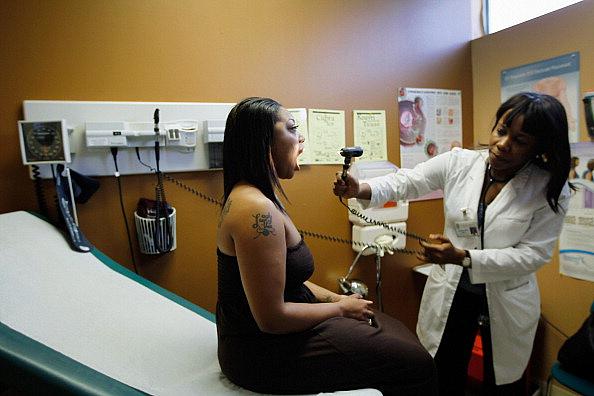Federal funding for programs helping community clinics offer care set to expire this week

Funding for programs that enable community clinics to provide care nationwide will expire on September 30th, if Congress doesn’t act to renew them. Since the passage of the Affordable Care Act (ACA), millions of newly-covered Americans now seek primary care services and community clinics have played an important role in providing that care. In Los Angeles, nonprofit community clinics and health centers have drastically expanded their services to meet this new demand for care, growing from 1.2 million patients in 2010 to 1.5 million in 2015.
The expansions of the ACA have made health care an area of major job growth because more providers are needed as more Americans now have health insurance. In 2015, JP Morgan Chase found that health care comprises the bulk of LA’s middle-skill job growth. According to the National Center for Health Workforce Analysis, the national demand for primary care physicians will exceed the supply by 23,640 providers in 2025.
Community clinics face their own specific workforce challenges as they seek to provide care for underserved communities. Clinics across the country, including Community Clinic Association of Los Angeles County (CCALAC), are working to expand the pipeline of qualified candidates going into primary care; to more effectively recruit new staff; and to retain their current workers.
Expanding the Pipeline
The first challenge for California and beyond is that they country is not producing enough graduates to meet growing primary care needs, especially in underserved communities[1]. Clinics are working to boost the number of graduates in primary care and strengthen primary care career awareness.
One way is through the Teaching Health Center Graduate Medical Education (THCGME) program, established by the ACA to fund primary care residency programs. While other residency programs base training out of hospitals, Teaching Health Centers train in community-based primary care settings. This academic year, the program is supporting 732 residents in 57 primary care residency programs, across 24 states. From 2011 to 2016, the program produced 384 new primary care physicians and dentists. This year California will build on the federal model, investing $33 million investment in primary care residency training and programs through the Song-Brown Workforce Training Program and Teaching Health Centers. The federal Teaching Health Center program is one utilized by community clinics that’s set to expire at the end of this week.
To increase awareness of primary care career opportunities, CCALAC is placing 30 AmeriCorps volunteers across 16 clinics to conduct a variety of capacity building as well as patient engagement projects, such as volunteer program development, health education, quality improvement and new program development. The AmeriCorps members are largely college graduates considering careers in medicine or public health. Several clinics are also working with LA Trade Tech to expose their nursing and pre-nursing students to clinic career opportunities through job shadowing and other events.
Recruiting Clinic Workers
With a limited supply of qualified candidates, clinics struggle to fill their open positions. A 2015 survey of CCALAC member clinics found 170 physician vacancies and 116 mid-level provider vacancies. Clinics surveyed described these as “hard to fill” positions, with many positions open for over a year due to the limited number of skilled candidates willing to serve in already under-resourced communities.
Clinics are working to even their odds in recruiting with a variety of programs aimed at exposing graduates to clinic careers and offering financial incentives for working in the safety net. By offering hands-on experience for a variety of jobs, clinics hope to entice these graduates to choose clinic careers compared to working in larger health systems, such as Kaiser Permanente and area hospitals.
Several programs help clinics offer more financial incentives so that they can compete for candidates with larger, more-resourced health systems. The National Health Service Corps, also set to sunset on September 30th, offers scholarships and loan repayment to providers agreeing to serve at clinics in underserved communities. California clinics also take advantage of a handful of state-level loan repayment programs, operated by California’s Health Professions Education Foundation, that offer loan repayment for service in underserved areas.
Retaining the Current Workforce
With competition for qualified candidates high, LA’s clinics struggle to keep their current workers. From July 2016 to April 2017, 25 health centers in Los Angeles experienced an average 26% turnover in their providers. This includes doctors, physician assistants, licensed clinical social workers, certified nurse midwives and nurse practitioners.[1]
Clinics are working to develop their workforce from within, supporting the development of staff in a variety of areas. In LA, some clinics are fostering partnerships that focus on skill development for their allied health professionals. ChapCare, one of our member clinics, recently launched a Certified Medical Assistant (CMA) Program for its current Medical Assistants (MAs). ChapCare pays its MAs while they complete CMA test-prep, courses, and testing, and also covers the certification exam fees. The clinic hopes that this investment in its workers will reap rewards in staff retention and satisfaction, in addition to improving care.
An Uncertain Future
As clinics work to expand and transform their work force, the future of their system hangs in the balance. Without action by Congress, a host of critical health programs—the Children’s Health Insurance Program (CHIP), Community Health Centers, Teaching Health Centers and National Health Service Corps programs—will all expire at the end of this week.
Photo Credit: Joe Raedle / Getty Images
[1] Richard L. (2017). Community Clinic Association of Los Angeles County. [Los Angeles Practice Transformation Network.] Unpublished raw data.

